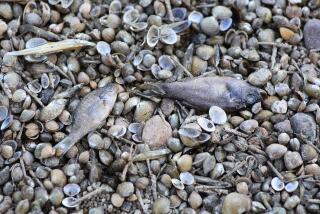L.A. River untouched by the water shortage
This is the driest year on record in Los Angeles, yet the city’s namesake river is defying nature with an abundant stream of water, which, miles to the south, has created a rare oceanside sanctuary for thousands of shorebirds.
The source of this water: the bountiful wastewater of a parched city.
Most Los Angeles River water is so-called recycled water, highly treated wastewater from upstream treatment plants that has no other place to go.
Although recycled water can be used for irrigation and to replenish underground aquifers, there are no pipes to transport it to far-off parks and golf courses.
The city uses the recycled water for only 1% of its irrigation needs. The vast majority from two Valley plants ends up in the river.
Homeowners with lush, overwatered lawns and squeaky-clean cars feed the flow. So do emerald-green golf courses fed with drinkable rather than recycled water.
Experts estimate that in addition to recycled water, about 32% of the river’s flow is fed by urban runoff and 4% is natural groundwater.
With so much water, the river’s lower reaches in Compton, Paramount and Long Beach have become a mecca for native and migratory shorebirds that once frequented the region’s coastal salt marshes. Over time, 95% of those marshes have been filled or paved over, and the man-made flow of the river has emerged as an unlikely oasis for the birds.
“It’s one of the most important bird stopovers in Southern California,” said Garry George, executive director of the Los Angeles Audubon Society.
This scenario comes at a time of water restrictions in some cities and admonishments to Los Angeles residents that they must conserve.
Meteorologists are predicting a La Nina winter, which typically means scant rainfall in Southern California.
To the east, an eight-year drought is racking the Colorado River Basin. To the north, a judge’s ruling protecting the delta smelt could curtail water deliveries from the Sacramento Delta by 30%.
The snowpack last week was 3% of normal for this time of year in the Sierra Nevada, said meteorologist Kevin Durfee at the National Weather Service.
“We’re bone dry right now,” Durfee said.
Last week, the Metropolitan Water District announced that it would buy large amounts of water from Central Valley farmers at higher than normal prices in hopes of staving off water shortages. The district, which imports water to serve 26 cities and water agencies, warned that rate increases might be in the offing.
Long Beach has imposed mandatory restrictions on lawn sprinkling and other water uses. Los Angeles Mayor Antonio Villaraigosa’s call for a voluntary 10% reduction in water use has fallen short so far. The city plans to wait several more months before deciding whether to impose restrictions.
But neither drought nor rationing will reduce the water supply to the L.A. River anytime soon, as millions of gallons are pumped from the Donald C. Tillman and Los Angeles-Glendale treatment plants.
The Tillman plant produces 56,000 acre-feet of water annually. Large amounts of water are measured by acre-feet, or the amount of water needed to cover an acre to a depth of 1 foot. One acre-foot is enough to serve two homes for a year.
One acre-foot of that water is used to irrigate the nearby Woodley Golf Course in Van Nuys. An additional 27,000 acre-feet is used to irrigate the plant’s Japanese gardens and replenish Balboa Lake and Wildlife Lake before flowing into the river. The rest is dumped into the river.
“It’s high-quality water. We could use some more customers,” said plant manager Hiddo Netto.
By 2013, the city hopes to use 5,149 more acre-feet of Tillman water on four more golf courses and for other uses. The city has 10 miles of pipeline that it laid for a $55-million project that would have used Tillman water to replenish underground aquifers in the Valley. The plan died amid residents’ opposition.
As the wastewater river passes under the 105 Freeway, forces of nature take over and birds start swooping down.
Bird watchers gather along the banks in Paramount and Compton and northern Long Beach. Commuters on the San Diego and Long Beach freeways can watch birds swirl overhead.
“A truly unique (yet nearly entirely un-natural) site, this 7-mile stretch of concrete channel . . . is one of the most important shorebird stopover sites in Southern California,” according to “Important Bird Areas of California,” a book published by Audubon California.
Peregrine falcons and white-tailed kites feed there all year. Cinnamon teal, northern pintail and other waterfowl pass through in autumn to forage near the Willow Street bridge in Long Beach. Great blue herons hunt for fish. Sandpipers and plovers abound.
They appear to flourish in recycled water and runoff. Some black-necked stilts even nest in the river, on little islands of vegetation.
“We don’t see any obvious negative impacts on the birds. The young stilts seem to have the right number of legs and eyes,” said Kimball L. Garrett, ornithology collections manager at the Natural History Museum of Los Angeles County.
Even if Los Angeles starts using more of its water, plenty will remain for the birds, city officials and bird experts say. In fact, the birds could use a little less wastewater in the runoff-heavy summer and fall, because lower levels make perching and feeding easier, Garrett said.
“No way am I saying that the concrete L.A. River channel is the ideal shorebird habitat,” he said. “But it’s the best we have left.”
--
More to Read
Sign up for Essential California
The most important California stories and recommendations in your inbox every morning.
You may occasionally receive promotional content from the Los Angeles Times.










